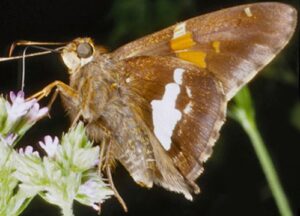 On mornings in the late summer and early fall, I wait for the sun to rise high enough for the asters and other flowers to open. That magic moment should be heralded by trumpets, but since I live in the suburbs, that will never happen.
On mornings in the late summer and early fall, I wait for the sun to rise high enough for the asters and other flowers to open. That magic moment should be heralded by trumpets, but since I live in the suburbs, that will never happen.
Even without trumpets, though, the daily grand opening of the flowers brings out the skippers, and the skippers bring joy to the garden. In late summer, those skippers tend to be the silver-spotted variety—at least in my garden. Later on, when the asters are in full swing, billowing out over the walkways and lawn, the silver-spots are less prominent than the non-spotted varieties. Both kinds flit dizzyingly from bloom to bloom, spreading the pollen and sipping the nectar. Watching them is life-affirming.
What is a skipper? It’s a good question and one that continues to cause discussion among taxonomists. A skipper looks and behaves like a cross between a moth and a butterfly. For scientific purposes, taxonomists have most recently put it in the butterfly or papillionoidea “super family”. Active in the daytime, they are smaller than most butterflies and tend to be dusky shades of gray, brown, and darker brown like many moths. This sounds completely uninteresting, but it is helpful to know that some, like my favorite, the silver-spotted skipper, have eye-catching markings.
The important thing to know is that the world is full of skippers—over 3,500 species. Many of them live in the northern hemisphere and even scientists have trouble telling species apart. Fortunately, that doesn’t matter to the average gardener or nature lover.
What matters is that skippers feature stocky bodies, like moths and share the somewhat hairy appearance of their moth relatives. Their antennae look more butterfly-like, but instead of the club-like tips of butterfly antennae, skippers’ antennae ends are hooked or comb-like. If you were able to look deeply into a skipper’s eyes, you would note that they are very large—much larger than those of either butterflies or moths—and compound.
Most of us will never stare soulfully into the eyes of a skipper, but we can observe their darting flight patterns as they move from flower to flower. When they settle down on individual flowers, they never stay for long, so they must be speedy nectar-sippers. At rest, the skippers in my garden usually hold their wings upward at an angle, rather than flattening them out like moths.
The silver-spotted skipper is larger and flashier than most, with a two-inch wingspan. The size and spotted wings make the fast flyers easier to recognize than most of their relations. Despite bearing the eternal burden of a tongue-tangling scientific name–Epargyreus clarus—the insects are widely distributed throughout the eastern half of the United States and southern Canada. Silver spots also put in appearances in some mountainous areas of the western United States. Wherever they show up, their wings are basically brown, with some lighter brown patches, pale wing edges and large, white spots on the undersides.
Silver-spotted skipper caterpillars are also eye-catching, but not particularly attractive, with bright yellow bodies, narrowly striped with dark green and large brown heads marked by caramel-colored eyes. Larval host plants include some garden-worthy members of the legume or Fabiaceae family, like the popular baptisia and wisteria, as well as black locust trees, which fall into the same family.
The adult silver spots feed on a number of summer and early fall garden flowers, like zinnias and various types of asters. In common with their butterfly relatives, skippers sport long tongues or proboscis that act like straws and allow the hungry insect to suck nectar out of flowers.
Why should gardeners care about skippers? Because they are a lovely in their own way, with interesting flight patterns that contribute life and movement to the garden. Even more important, they are a sign of a healthy garden ecosystem. I agree with the writer who said that if you have lots of skippers, you know you are doing something right.
